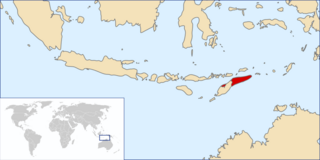|
|
East TimorFrom Researching Virtual Initiatives in EducationPartners situated in East TimorNone. East Timor in a nutshellEast Timor, also known as Timor-Leste (officially the Democratic Republic of Timor-Leste) is a country in Southeast Asia. It comprises the eastern half of the island of Timor, the nearby islands of Atauro and Jaco, and Oecussi-Ambeno, an exclave on the northwestern side of the island, within Indonesian West Timor. The small country of 15,410 sq km (5,400 sq mi) is located about 640 km (400 mi) northwest of Darwin, Australia. East Timor was colonized by Portugal in the 16th century, and was known as Portuguese Timor until Portugal's decolonization of the country. In late 1975 East Timor declared its independence but was occupied by Indonesia later that year, and declared that country's 27th province the following year. In 1999, following the United Nations-sponsored act of self-determination, Indonesia relinquished control of the territory and East Timor became the first new sovereign state of the twenty-first century on May 20, 2002. East Timor is one of only two predominantly Roman Catholic countries in Asia, the other being the Philippines. The official languages are the national language of Tetum with Portuguese as the other. East Timor education policy(sourced from http://www.nationsencyclopedia.com/Asia-and-Oceania/East-Timor-EDUCATION.html - this is rather old - 2001) Over 90% of all school buildings were severely damaged or destroyed by the former Asian occuping power and in the exodus of their army out of East Timor, the nation lost 20% of its primary school teachers and 80% of secondary teachers, most of whom are not expected to return. UNICEF and other international aid organizations responded fairly quickly, however, reestablishing classes for 420 of the country's 800 primary schools by December 1999 plus an additional 273 schools by April 2000. In 2001, East Timor appointed its first minister of education. At the beginning of the 2001 academic year, there were about 240,000 primary and secondary school students enrolled in classes with over 700 primary schools, 100 junior secondary schools, 40 preschools, and 10 technical colleges. About 6,000 teachers were employed. The National University of East Timor (Universidade Nacional Timor Lorosae—UNTL) opened for classes on 27 November 2000 and had about 5,000 students in attendance in 2003. There are five faculties at the university: agriculture, political science, economics, education and teacher training, and engineering. All new students follow a course including human rights, ethics, philosophy of science, and Timorese history. The education system includes six years of primary education and six years of secondary education. The new minister of education will need to address the issues of continued repairs and rebuilding of schools, providing adequate training for teachers, and establishing a standardized curriculum relevant to East Timorese students. The literacy rate as of 2001 was 48% of the population ages 15 and over.
East Timor education systemHigher educationUniversities in East TimorPolytechnics in East TimorHigher education reformThe Bologna ProcessAdministration and financeQuality assuranceCountry's HEIs in the information societyICT in education is at a very early stage and telecommunications is not well developed.
Towards the information societyInformation society strategyVirtual Campuses in HEInteresting Virtual Campus InitiativesInteresting Programmes
Re.ViCa Case-studyNone.
Lessons learntNone.
References |
